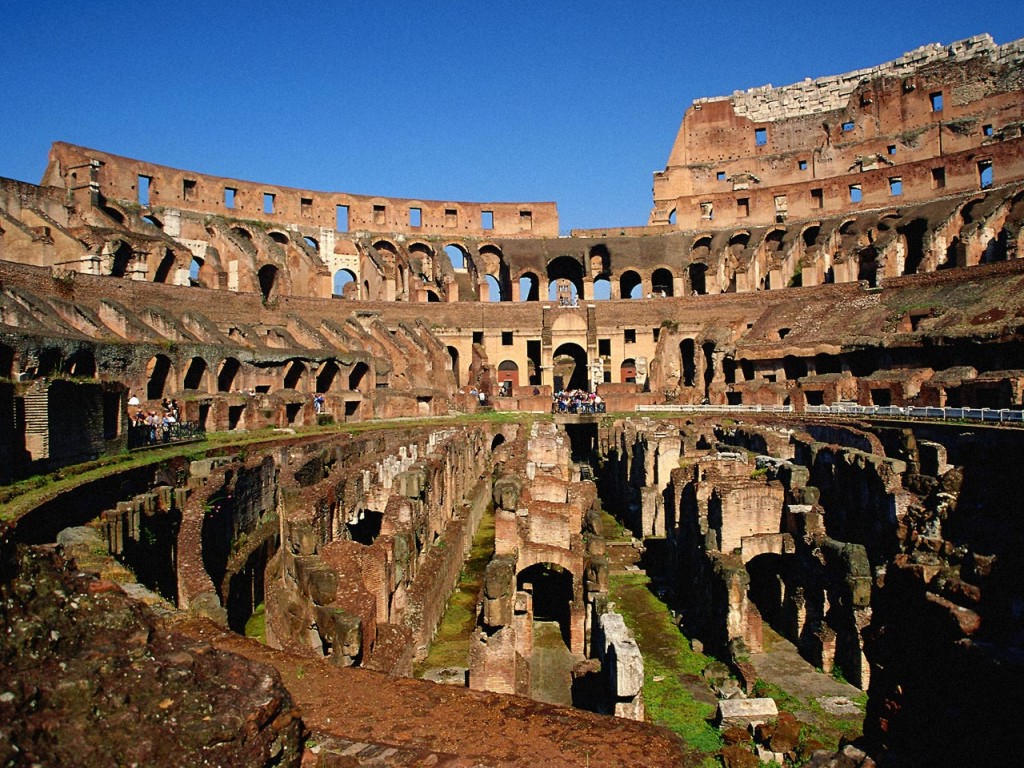
THE COLOSSEUM.
THE inhabitants of Rome, during the height of that city's power, found great pleasure in witnessing bloodshed. In their struggles for office and fame, ambitious states-men took advantage of this weakness in the people, and sought to gain their favor and support by providing them with amusements of this demoralizing character. Slaves and prisoners taken in war were trained in the art of killing one another. These trained combatants, called gladiators, were compelled to fight with one another, and with wild beasts, in the presence of vast crowds. Wild beasts were left unfed for several days, and then let loose upon each other for the amusement of the beholders. So attractive were these cruel sports made, that it became impossible to accommodate the immense crowds that assembled to witness them. This state of things gave rise to the building of amphitheatres, or vast buildings in which the people were seated all around an open center, called the arena. In this arena the gladiators and wild beasts fought.
Nearly one hundred of these amphitheatres are known to have existed in the southern part of Europe. The largest and most magnificent of these structures was the one at Rome. It was begun by the Emperor Vespasian, and completed by his son, Titus, A. D. 80. The ruins of this stupendous pile as they now appear from the outside, are presented in the picture. The colossal proportions of this structure led to its being distinguished from all other amphitheatres by the name, Colosseum.
Though for centuries it served as a quarry from which material was obtained for palaces and churches, it still stands—
"A noble wreck in ruinous perfection,
While Caesar's chambers and Augustan halls
Grovel on earth in indistinct decay."
It is pronounced by all to be "the grandest ruin in the world." Some idea of its size may be gathered from the following figures:—
The building was oval in form, its greatest length being 612 feet, and its greatest width 515 feet.
The arena was of the same form as the outside of the building, and was at least 250 feet long by 150 in width. The height of the building was 160 feet, while the whole structure covered an area of nearly six acres. The arena was surrounded by a wall 15 feet high, which was made of polished marble so that the wild beasts could not by any possibility climb it, and was surmounted by a bronzed railing or network. On a level with the top of this wall was the first platform, which extended entirely around the arena, and was occupied by the noblest of Rome's citizens, including the emperor and senators. From the top of the wall that formed the back of this platform rose a second platform, and above and back of the second, rose a third, and likewise a fourth, which reached back to the outer wall of the building. Thus the view presented on the inside was that of an immense basin, with thousands of people clinging to its sides. Within this spacious enclosure were seats for 87,000 people,. while 15,000 more could be provided with standing room. At each end of the arena was a large door for the entrance of men and beasts. The latter were kept in dens under the platforms, and were sometimes driven out upon the arena from small doors in the side of the wall surrounding the arena.
Lack of space forbids a description of the splendor and magnificence with which the interior was adorned. Marble statuary, gilded pillars and arches, ivory trimmings, and silken awnings made the place as attractive as it was possible for art and wealth to do. And yet we turn with disgust from the thought that all this outlay of human skill and labor was to furnish a hundred thousand of the citizens of Rome a view of their fellow-men being hewn, and hacked, and torn, until the whole arena was strewn with their dead bodies, and its soil literally drenched with their blood.
During the persecutions of the early Christians, many noble martyrs lost their lives in the arena of the Colosseum, while the Roman populace taunted and jeered them in their dying agonies.
But in A. D. 500 the emperor Theodoric put a final stop to all kinds of bloodshed in the Colosseum, and from that time to the present day the place has been deserted and left to decay. Trees have taken root in the crevices of its stones, and vines, bearing rare and beautiful flowers, twine over its walls and arches. Yet so massive were its walls, so admirably fitted were its arches and galleries, and so stupendous was the whole mighty structure, that it has with-stood the pillages of both man and time, and still remains a monument to man's intellect, and a reminder of the good he is able to accomplish when his powers are sanctified to the glory of his Creator.
C. H. G.